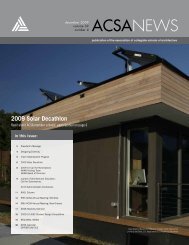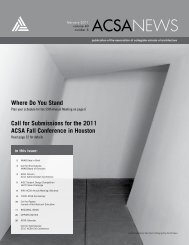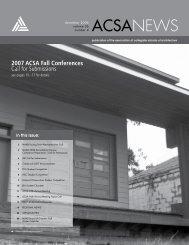digital aptitudes - Association of Collegiate Schools of Architecture
digital aptitudes - Association of Collegiate Schools of Architecture
digital aptitudes - Association of Collegiate Schools of Architecture
You also want an ePaper? Increase the reach of your titles
YUMPU automatically turns print PDFs into web optimized ePapers that Google loves.
THURSDAY, MARCH 1, 2012 - 12:00PM - 1:30PM<br />
Design Computation: Parametrics, Performance,<br />
Pedagogy and Praxis<br />
Karen Kensek, University <strong>of</strong> Southern California<br />
Folded Sun-Shades: From Origami to <strong>Architecture</strong><br />
Nancy Yen-wen Cheng, University <strong>of</strong> Oregon<br />
Abraham Rodriguez, University <strong>of</strong> Oregon<br />
Ashley Koger, University <strong>of</strong> Oregon<br />
This paper describes a hybrid <strong>digital</strong>+physical process for designing<br />
decorative and functional sun-shading screens that flex to meet<br />
changing diurnal and seasonal lighting requirements. A range <strong>of</strong><br />
techniques was used to optimize the visual effects created from a<br />
single sheet. Experiments in cutting and folding were combined<br />
with photography and solar testing using a heliodon and artificial<br />
sky. Material characteristics discovered through physical manipulation<br />
and direct observation shaped the geometric transformation<br />
and parametric modeling <strong>of</strong> lasercut patterns. The paper illustrates<br />
how each technique shaped the design development in a delicate<br />
balance <strong>of</strong> directed study and serendipitous discovery.<br />
Beyond demonstrating possibilities and limitations <strong>of</strong> cut and folded<br />
contiguous sheets as lighting modulators, the project shows<br />
how a material study can be targeted towards architectural applications.<br />
Defining a specific architectural problem is crucial for<br />
focusing the work towards building performance. The context<br />
limits the design exploration and sharpens the defining questions.<br />
For the <strong>digital</strong>+physical design process to trigger different modes<br />
<strong>of</strong> thinking, design education and the studio environment need to<br />
support agile shifts between design methods. Bringing together individuals<br />
with complementary skills and backgrounds enriches how<br />
a project can take advantage <strong>of</strong> these multiple modes.<br />
Performance-Based Generative Design. An<br />
Investigation <strong>of</strong> the Parametric Nature <strong>of</strong><br />
<strong>Architecture</strong><br />
Ming Tang, University <strong>of</strong> Cincinnati<br />
This paper investigates a collaborative research and teaching project<br />
between the University <strong>of</strong> Cincinnati, Perkins+Will’s Tech Lab<br />
and nD group, and the University <strong>of</strong> North Carolina Greensboro. The<br />
primary investigation focuses on the design and fabrication <strong>of</strong> building<br />
components, derived from performance-based parameters. The<br />
project examines various approaches including theoretical investigations<br />
and proprietary s<strong>of</strong>tware tools for parametric design.<br />
The paper first gives a short historical and philosophical background<br />
to performance-based design, then describes the technical and algorithmic<br />
requirements, and concludes with the examples <strong>of</strong> implementation.<br />
With two design courses taught in 2011, the authors discuss<br />
the “shared body plan” as an essential element for applying<br />
generative form-seeking methods in architectural design. Design<br />
methodologies, such as use <strong>of</strong> building performance simulation<br />
tools, genetic morphing, and fitness evaluations are discussed as<br />
new paradigms in generative, performance-based design.<br />
This paper also investigates how the large quantity <strong>of</strong> iterations can<br />
be filtered and selected based on the feasibility <strong>of</strong> fabrication and<br />
materialization processes. Using several student projects, the paper<br />
demonstrates the methods <strong>of</strong> mass customization and parametric<br />
iteration through physical prototyping.. The parameters related with<br />
fabrication have been implemented to generate a large quantity <strong>of</strong><br />
creative solutions, whereas genetic algorithm functions are introduced<br />
as optimizers.<br />
As a conclusion, this paper summarizes the formation process that<br />
nature permits in order to sustain a generative system. The paper analyzes<br />
several design and prototyping procedures, and illustrates how<br />
these performance-driven design approaches can be used for innovative<br />
forms, utilizing benefits <strong>of</strong> performance-based influences in architecture<br />
beyond formal assumption and aesthetic experimentation.<br />
Material in Performance-driven Architectural<br />
Geometry<br />
Sevil Yazici, Istanbul Technical University<br />
Leyla Tanacan, Istanbul Technical University<br />
Advanced Computer Aided Design Techniques liberated non-Euclidian<br />
geometries such as freeform surfaces. In today’s architectural<br />
practice, there is a necessity to subdivide complex geometries<br />
into smaller components for realization <strong>of</strong> buildings because <strong>of</strong> the<br />
current limitations in Computer Aided Manufacturing Techniques.<br />
Architectural geometry is an emerging field <strong>of</strong> research focusing<br />
on rationalization <strong>of</strong> freeform surfaces. This field <strong>of</strong> research is investigated<br />
with panelization tools. However, these tools are not<br />
able to accommodate requirements related to the material properties<br />
and building performance. Today, computational tools associated<br />
with performance analysis, evaluation and optimization are<br />
undertaken during a later stage <strong>of</strong> the design process, following<br />
the form generation. This paper aims to discuss how material can<br />
be integrated into a parametric model in which architectural geometry,<br />
material and building performance are interdependent for<br />
increasing efficiency in the design process. A parametrically defined<br />
architectural surface is generated, analyzed and evaluated as<br />
a case study where parametric modeling, panelization tools and<br />
series <strong>of</strong> analysis tools including Finite Element Method Analysis<br />
are used with the intent <strong>of</strong> mapping critical procedures towards<br />
building a complex architectural surface. Different types <strong>of</strong> materials<br />
are tested for the surface within imposed boundary conditions<br />
to assess and compare their structural performance. Future lines <strong>of</strong><br />
research are indicated in the paper.<br />
Signature <strong>Architecture</strong> Franchising: Improving<br />
Average <strong>Architecture</strong> Using BIM<br />
Ehsan Barekati, Texas A&M University<br />
James Haliburton, Prairie View A&M University<br />
Mark Clayton, Texas A&M University<br />
Ozan Ozener, Texas A&M University<br />
Building Information Modeling provides capabilities to aid architectural<br />
design that are so revolutionary as to enable new forms<br />
<strong>of</strong> practice. Signature architecture franchising is a design process<br />
and workflow that makes use <strong>of</strong> a “seed” BIM that a designer can<br />
modify rapidly to create a custom design. The design can be constrained<br />
to conform to characteristics <strong>of</strong> a signature architectural<br />
style through use <strong>of</strong> constraints, components and standard assemblies<br />
or families. The design can also be subjected to rigorous analysis<br />
for performance in domains such as energy consumption, construction<br />
cost and construction schedule. Experiments that have<br />
been conducted to explore and test the idea indicate that signature<br />
architecture franchising appears feasible. It may enable designers<br />
to expand market share and increase quality significantly, perhaps<br />
enabling substantial reductions in energy consumption in average<br />
buildings in the future.<br />
Digital Apptitutes + Other Openings - Boston, MA - 5








